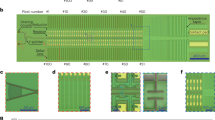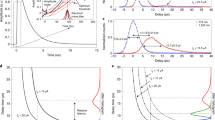Abstract
Scaling superconducting nanowire single-photon detectors into a large array to obtain imaging capability is desired for applications in photon-starved conditions, considering the outstanding performance already demonstrated on a single detector. However, this is challenging because the ultralow operation temperature only allows specific electronics of ultralow power dissipation to work. Here we develop a kilopixel imager by introducing an orthogonal time–amplitude-multiplexing method. This readout is solely built in the superconducting nanowire by geometrically designing the nanowire structure to manipulate its hotspot growth and microwave propagation after photon detection. As a result, pixel locations are encoded on both time and amplitude domains of the output pulses. This dual multiplexing method overcomes the previous limitation of a time-multiplexing readout, where the time measurement uncertainty deteriorates the spatial resolution and scalability. Experimentally, with two readout lines, we have demonstrated a 32 × 32 imager with an average readout pixel fidelity of 97% and an average temporal resolution of 67.3 ps. The performance of this imager is further verified by single-photon imaging experiments at a low photon flux down to one detected photon per pixel. This orthogonal time–amplitude-multiplexing readout and corresponding nanowire designs give the most efficient readout compared with previous methods, which would speed up the development of large-scale single-photon imagers for quantum measurements, remote sensing, astronomical telescopes and so on.
This is a preview of subscription content, access via your institution
Access options
Access Nature and 54 other Nature Portfolio journals
Get Nature+, our best-value online-access subscription
$29.99 / 30 days
cancel any time
Subscribe to this journal
Receive 12 print issues and online access
$209.00 per year
only $17.42 per issue
Buy this article
- Purchase on Springer Link
- Instant access to full article PDF
Prices may be subject to local taxes which are calculated during checkout




Similar content being viewed by others
Data availability
The data that support the findings of this study are available from the corresponding authors upon reasonable request.
References
Moreau, P.-A., Toninelli, E., Gregory, T. & Padgett, M. J. Imaging with quantum states of light. Nat. Rev. Phys. 1, 367–380 (2019).
Ndagano, B. et al. Imaging and certifying high-dimensional entanglement with a single-photon avalanche diode camera. npj Quantum Inf. 6, 94 (2020).
Camphausen, R. et al. A quantum-enhanced wide-field phase imager. Sci. Adv. 7, eabj2155 (2021).
Altmann, Y. et al. Quantum-inspired computational imaging. Science 361, eaat2298 (2018).
Shin, D. et al. Photon-efficient imaging with a single-photon camera. Nat. Commun. 7, 12046 (2016).
Kong, L. et al. Noise-tolerant single-photon imaging with a superconducting nanowire camera. Opt. Lett. 45, 6732–6735 (2020).
Cheng, R. et al. Broadband on-chip single-photon spectrometer. Nat. Commun. 10, 4104 (2019).
Kahl, O. et al. Spectrally multiplexed single-photon detection with hybrid superconducting nanophotonic circuits. Optica 4, 557–562 (2017).
Itzler, M. A. et al. Advances in InGaAsP-based avalanche diode single photon detectors. J. Mod. Opt. 58, 174–200 (2011).
Jiang, X. et al. InP-based single-photon detectors and Geiger-mode APD arrays for quantum communications applications. IEEE J. Sel. Topics Quantum Electron. 21, 5–16 (2015).
Morimoto, K. et al. Megapixel time-gated SPAD image sensor for 2D and 3D imaging applications. Optica 7, 346–354 (2020).
Szypryt, P. et al. Large-format platinum silicide microwave kinetic inductance detectors for optical to near-IR astronomy. Opt. Express 25, 25894–25909 (2017).
Holland, W. S. et al. SCUBA-2: the 10 000 pixel bolometer camera on the James Clerk Maxwell Telescope. Mon. Not. R. Astron. Soc. 430, 2513–2533 (2013).
Wollman, E. E. et al. Kilopixel array of superconducting nanowire single-photon detectors. Opt. Express 27, 35279–35289 (2019).
Reddy, D. V., Nerem, R. R., Nam, S. W., Mirin, R. P. & Verma, V. B. Superconducting nanowire single-photon detectors with 98% system detection efficiency at 1550 nm. Optica 7, 1649–1653 (2020).
Hu, P. et al. Detecting single infrared photons toward optimal system detection efficiency. Opt. Express 28, 36884–36891 (2020).
Chang, J. et al. Detecting telecom single photons with (\(99.5^{+0.5}_{-2.07}\))% system detection efficiency and high time resolution. APL Photonics 6, 036114 (2021).
Mueller, A. S. et al. Free-space coupled superconducting nanowire single-photon detector with low dark counts. Optica 8, 1586–1587 (2021).
Zhang, W. J. et al. Fiber-coupled superconducting nanowire single-photon detectors integrated with a bandpass filter on the fiber end-face. Supercond. Sci. Technol. 31, 035012 (2018).
Korzh, B. et al. Demonstration of sub-3 ps temporal resolution with a superconducting nanowire single-photon detector. Nat. Photon. 14, 250–255 (2020).
Caloz, M. et al. Intrinsically-limited timing jitter in molybdenum silicide superconducting nanowire single-photon detectors. J. Appl. Phys. 126, 164501 (2019).
Marsili, F. et al. Efficient single photon detection from 500 nm to 5 μm wavelength. Nano Lett. 12, 4799–4804 (2012).
Verma, V. B. et al. Single-photon detection in the mid-infrared up to 10 μm wavelength using tungsten silicide superconducting nanowire detectors. APL Photonics 6, 056101 (2021).
Allmaras, J. P. et al. Demonstration of a thermally coupled row-column SNSPD imaging array. Nano Lett. 20, 2163–2168 (2020).
McCaughan, A. N. et al. The thermally coupled imager: A scalable readout architecture for superconducting nanowire single photon detectors. Appl. Phys. Lett. 121, 102602 (2022).
Miyajima, S., Yabuno, M., Miki, S., Yamashita, T. & Terai, H. High-time-resolved 64-channel single-flux quantum-based address encoder integrated with a multi-pixel superconducting nanowire single-photon detector. Opt. Express 26, 29045–29054 (2018).
Zheng, K. et al. A superconducting binary encoder with multigate nanowire cryotrons. Nano Lett. 20, 3553–3559 (2020).
Doerner, S. et al. Frequency-multiplexed bias and readout of a 16-pixel superconducting nanowire single-photon detector array. Appl. Phys. Lett. 111, 032603 (2017).
Gaggero, A. et al. Amplitude-multiplexed readout of single photon detectors based on superconducting nanowires. Optica 6, 823–828 (2019).
Zhao, Q. et al. Superconducting-nanowire single-photon-detector linear array. Appl. Phys. Lett. 103, 142602 (2013).
Zhao, Q.-Y. et al. Single-photon imager based on a superconducting nanowire delay line. Nat. Photon. 11, 247–251 (2017).
Ejrnaes, M. et al. A cascade switching superconducting single photon detector. Appl. Phys. Lett. 91, 262509 (2007).
Yang, J. K. W. et al. Modeling the electrical and thermal response of superconducting nanowire single-photon detectors. IEEE Trans. Appl. Supercond. 17, 581–585 (2007).
Kerman, A. J., Yang, J. K. W., Molnar, R. J., Dauler, E. A. & Berggren, K. K. Electrothermal feedback in superconducting nanowire single-photon detectors. Phys. Rev. B 79, 100509 (2009).
Marsili, F. et al. Single-photon detectors based on ultranarrow superconducting nanowires. Nano Lett. 11, 2048–2053 (2011).
Marsili, F., Najafi, F., Herder, C. & Berggren, K. K. Electrothermal simulation of superconducting nanowire avalanche photodetectors. Appl. Phys. Lett. 98, 093507 (2011).
Zhu, D. et al. Resolving photon numbers using a superconducting nanowire with impedance-matching taper. Nano Lett. 20, 3858–3863 (2020).
Kong, L. et al. Probabilistic energy-to-amplitude mapping in a tapered superconducting nanowire single-photon detector. Nano Lett. 22, 1587–1594 (2022).
Colangelo, M. et al. Impedance-matched differential superconducting nanowire detectors. Preprint at https://arxiv.org/abs/2108.07962 (2021).
Zhang, W. et al. NbN superconducting nanowire single photon detector with efficiency over 90% at 1550 nm wavelength operational at compact cryocooler temperature. Sci. China Phys. Mech. Astron. 60, 120314 (2017).
Li, F. et al. Saturation efficiency for detecting 1550 nm photons with a 2 × 2 array of Mo0.8Si0.2 nanowires at 2.2 K. Photon. Res. 9, 389–394 (2021).
Acknowledgements
We thank the other RISE members for assistance in nanofabrication, measurements and providing instruments. This work was supported by the National Key R&D Program of China Grant (2017YFA0304002), the National Natural Science Foundation (nos. 62071214, 61571217 and 11227904), the Program for Innovative Talents and Entrepreneur in Jiangsu, the Fundamental Research Funds for the Central Universities, the Priority Academic Program Development of Jiangsu Higher Education Institutions (PAPD) and the Jiangsu Provincial Key Laboratory of Advanced Manipulating Technique of Electromagnetic Waves.
Author information
Authors and Affiliations
Contributions
L.-D.K. conceived the idea, designed and fabricated the device, implemented the experiments and developed the analysis methods. H.W. deposited the superconducting film. L.-D.K. and J.-W.G. performed the optical simulations. H.W., X.-C.T., L.-B.Z., X.-Q.J. and L.K. helped with the device fabrication. Y.-H.H., H.H. and S.C. helped with the cryogenic setup. Q.-Y.Z., J.C. and P.-H.W. supervised the work. L.-D.K. and Q.-Y.Z. wrote the manuscript.
Corresponding authors
Ethics declarations
Competing interests
L.-D.K. and Q.-Y.Z. applied for a Chinese patent (no. 202111220932.3). The remaining authors declare no competing interests.
Peer review
Peer review information
Nature Photonics thanks the anonymous reviewers for their contribution to the peer review of this work.
Additional information
Publisher’s note Springer Nature remains neutral with regard to jurisdictional claims in published maps and institutional affiliations.
Supplementary information
Supplementary Information
Supplementary Figs. 1–7 and discussion.
Rights and permissions
Springer Nature or its licensor holds exclusive rights to this article under a publishing agreement with the author(s) or other rightsholder(s); author self-archiving of the accepted manuscript version of this article is solely governed by the terms of such publishing agreement and applicable law.
About this article
Cite this article
Kong, LD., Wang, H., Zhao, QY. et al. Readout-efficient superconducting nanowire single-photon imager with orthogonal time–amplitude multiplexing by hotspot quantization. Nat. Photon. 17, 65–72 (2023). https://doi.org/10.1038/s41566-022-01089-6
Received:
Accepted:
Published:
Issue Date:
DOI: https://doi.org/10.1038/s41566-022-01089-6
This article is cited by
-
Scaling up single-photon detector arrays
Nature Photonics (2023)



